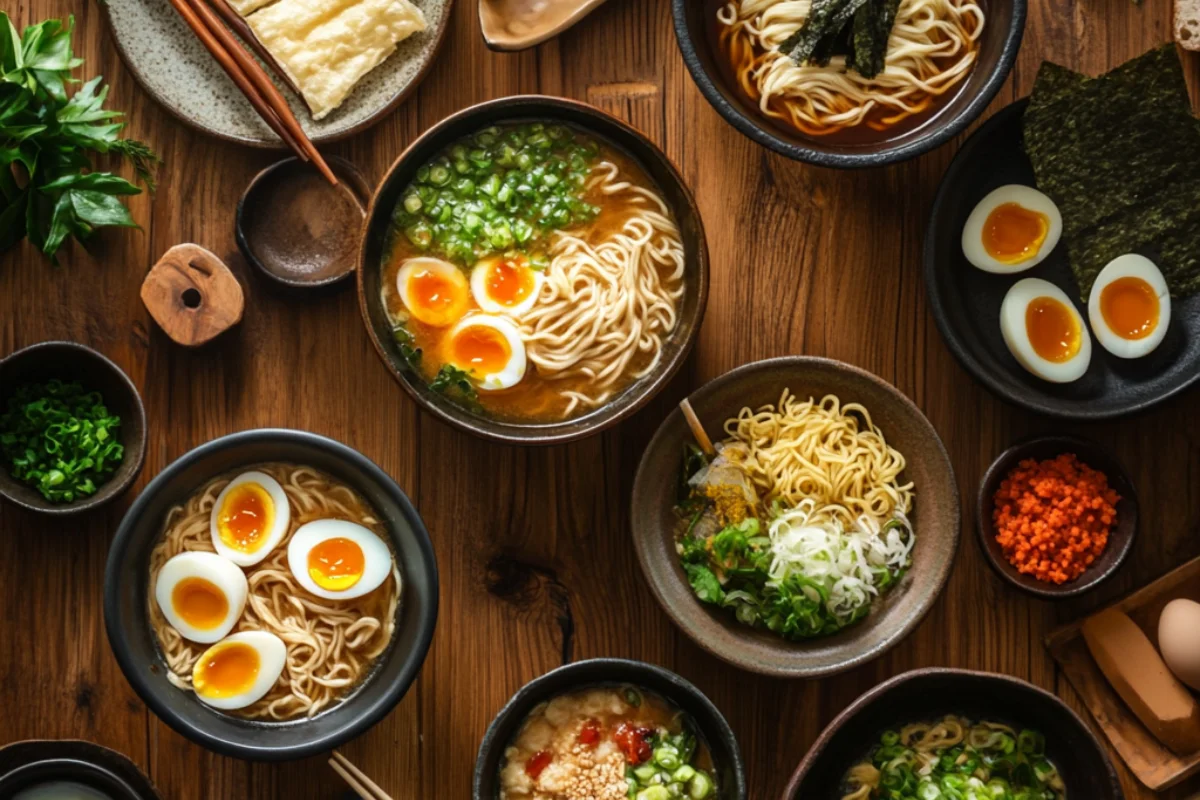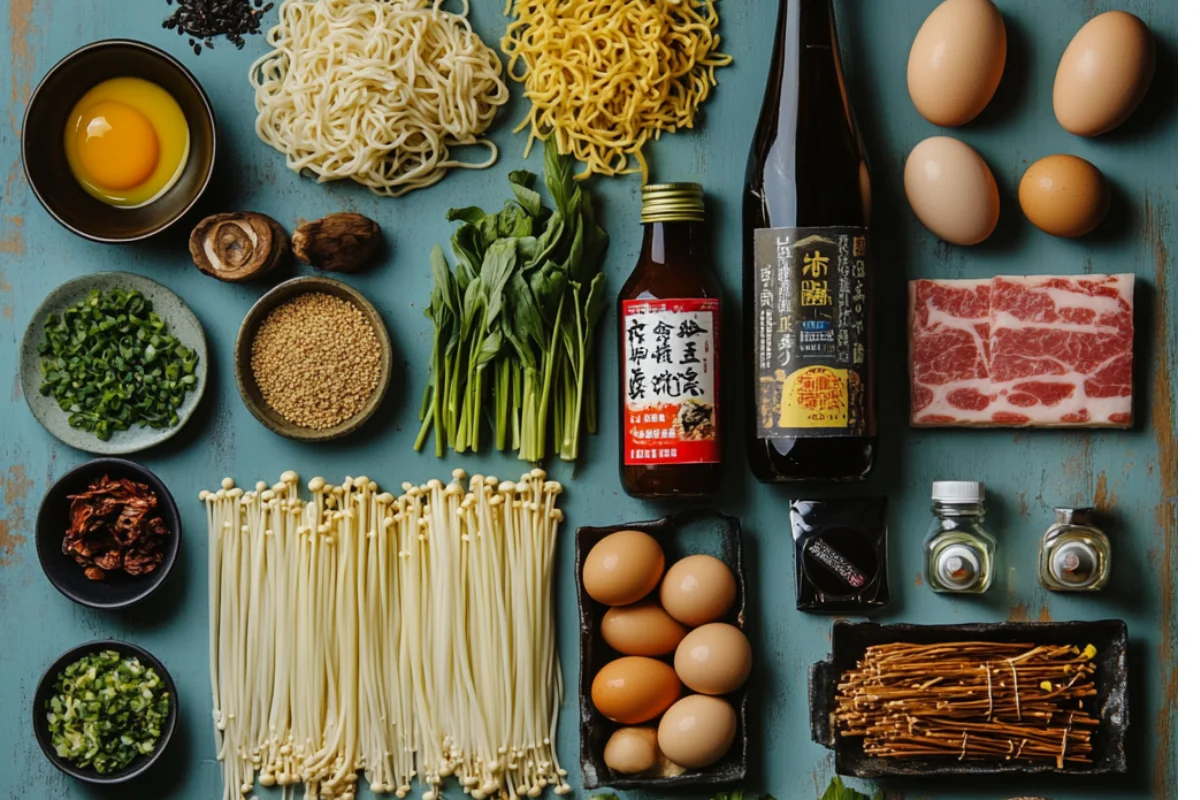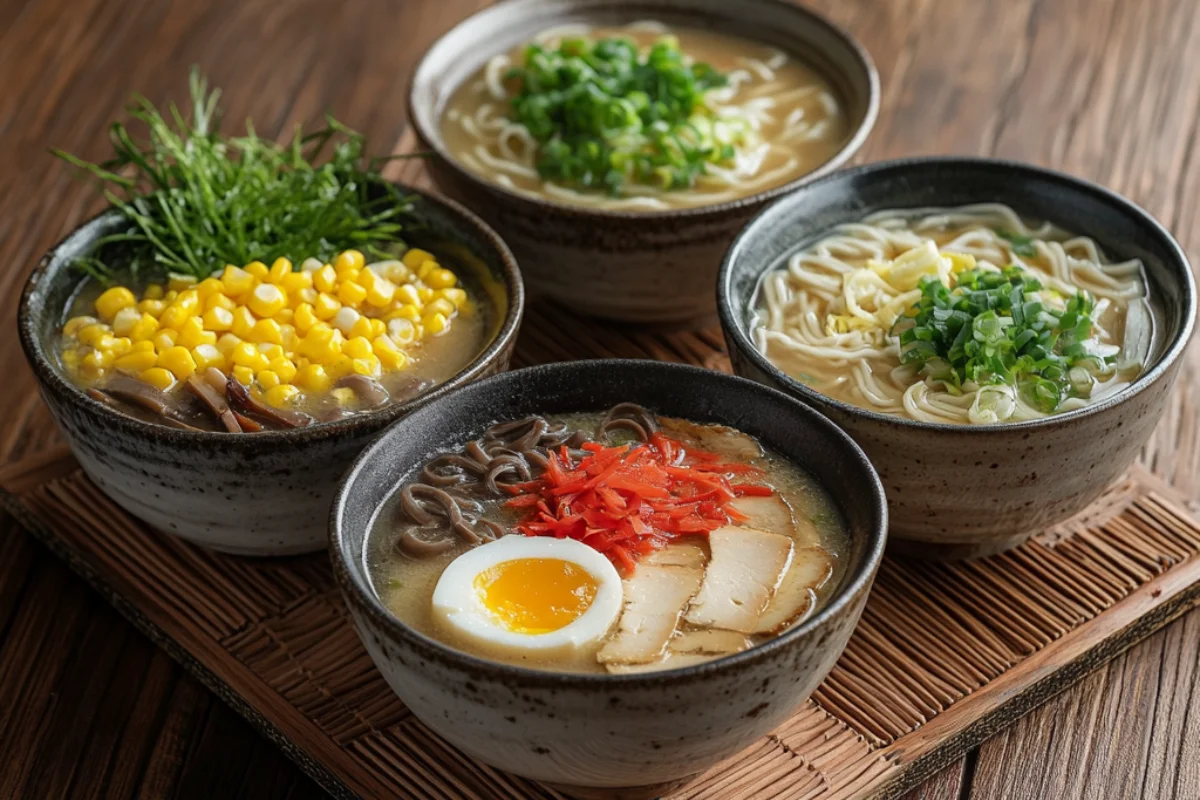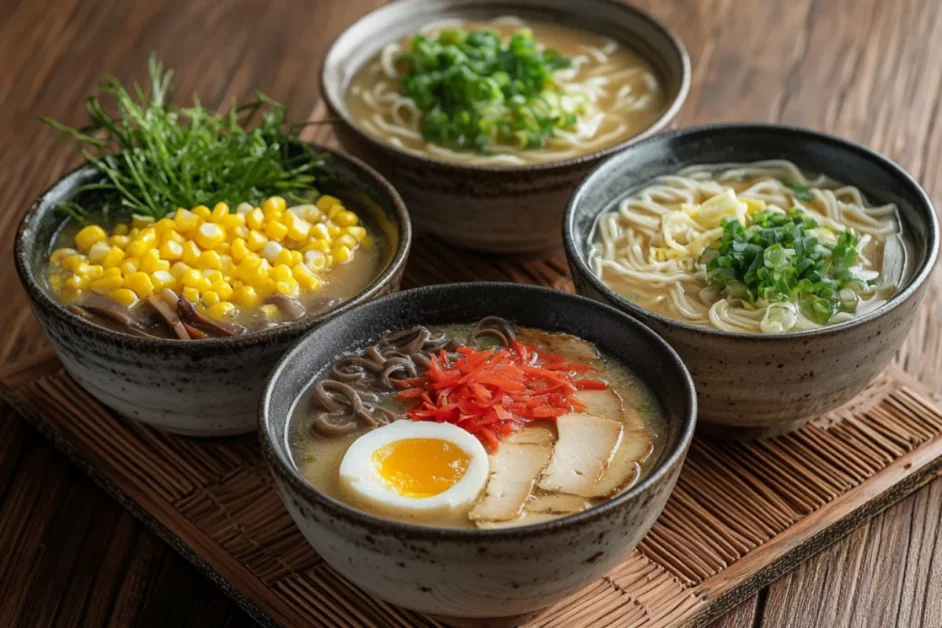Introduction to Japanese Noodle Soups

Japanese noodle soups are more than just a culinary delight; they are a window into the culture and traditions of Japan. From steaming bowls of ramen to hearty udon and delicate soba, these soups are deeply intertwined with Japanese life. Whether enjoyed at bustling street stalls or elegant restaurants, noodle soups carry a rich history and diverse flavors that make them a cornerstone of Japanese cuisine.
Cultural Significance of Noodle Soups in Japan
In Japan, food is not just about sustenance—it’s an art form and a way to connect with history and community. Noodle soups, in particular, hold a special place in Japanese culture.
- A Symbol of Warmth: A steaming bowl of noodle soup is often associated with comfort and togetherness, making it a go-to dish during colder months or communal gatherings.
- Celebratory and Everyday Fare: Whether celebrating milestones or grabbing a quick meal, noodle soups are adaptable to any occasion.
- Reflection of Regional Diversity: Each region in Japan has its signature noodle soup, showcasing local ingredients and culinary traditions.
Overview of Different Noodle Types and Broths
Japanese noodle soups are a beautiful marriage of noodles and broth. Let’s break down the stars of the show:
- Noodle Types:
- Ramen: Thin, wavy noodles with a chewy texture.
- Udon: Thick, soft noodles perfect for absorbing flavors.
- Soba: Made from buckwheat, offering a nutty taste and a firmer bite.
- Broth Varieties:
- Shoyu (Soy Sauce): A clear and light broth with a salty, umami profile.
- Miso: Rich and earthy, made with fermented soybean paste.
- Shio (Salt): Delicate and light, often paired with seafood.
- Tonkotsu: Creamy and indulgent, made by simmering pork bones for hours.
The History of Japanese Noodle Soups
Origin of Noodle Soups in Japanese Cuisine
The story of Japanese noodle soups dates back centuries and reflects the evolution of Japanese culinary traditions. Though noodles themselves were not native to Japan, they have become a beloved staple in the country.
- Early Beginnings: The first introduction of noodles to Japan is believed to have occurred in the 9th century, brought over by Chinese monks.
- Adoption and Adaptation: By the Edo period (1603–1868), noodle dishes like soba gained immense popularity, becoming a street food favorite.
- Modern Noodle Culture: Ramen, now an international icon, emerged in Japan in the early 20th century, inspired by Chinese la mian (pulled noodles).
Influence of Chinese Noodle Culture
Chinese cuisine had a profound influence on Japanese noodle soups, particularly ramen.
- Inspiration for Ramen: Chinese immigrants in the port cities of Yokohama and Kobe introduced noodle dishes that inspired Japanese chefs to create their versions.
- Fusion of Flavors: Over time, Japanese chefs infused their broths with local ingredients, creating distinct flavors that defined modern Japanese noodle soups.
Key Ingredients in Japanese Noodle Soups

The magic of Japanese noodle soups lies in the harmony of their ingredients. Each component plays a crucial role in delivering an unforgettable experience.
Common Noodles: Ramen, Udon, Soba
- Ramen Noodles:
- Typically made from wheat, water, and kansui (alkaline water).
- Available in varying shapes and textures, including curly and straight.
- Udon Noodles:
- Known for their thick, soft texture.
- Often served in hearty broths with mild seasonings.
- Soba Noodles:
- Made with buckwheat, these noodles are earthy and slightly nutty.
- Popular in both hot soups and chilled dishes.
Broth Varieties: Shoyu, Miso, Shio, and Tonkotsu
Each broth brings a unique character to the dish:
- Shoyu: Made with soy sauce, this broth is light yet packed with umami.
- Miso: Fermented soybean paste creates a creamy and tangy profile.
- Shio: Delicate and transparent, often highlighting seafood flavors.
- Tonkotsu: Rich and hearty, this broth owes its creaminess to pork bones simmered for hours.
Toppings: Nori, Scallions, Egg, Pork, and More
No bowl of Japanese noodle soup is complete without an array of toppings that enhance its flavors and texture:
- Nori (Seaweed): Adds a hint of brininess.
- Scallions: A fresh, sharp contrast to the rich broth.
- Soft-Boiled Egg: With a creamy yolk, it’s a luxurious addition.
- Chashu (Braised Pork): Tender slices of beef belly elevate the dish.
- Others: Bamboo shoots, fish cakes, and sesame seeds further enhance the complexity.
Traditional Cooking Methods
How Japanese Noodle Soups Are Prepared
The preparation of Japanese noodle soups requires skill, patience, and an eye for detail.
- Broth Preparation:
- Slow simmering is key to extracting flavors from ingredients like bones, vegetables, and seaweed.
- Shoyu, miso, shio, and tonkotsu broths each require specific techniques.
- Noodle Cooking:
- Fresh noodles are boiled to perfection, ensuring they retain the ideal texture.
- Timing is crucial to prevent overcooking.
- Assembly:
- Broth is ladled into the bowl first, followed by noodles, and finally topped with an array of garnishes.
Regional Techniques and Variations
Japan’s regional diversity shines in its noodle soups:
- Hokkaido Ramen: Known for miso-based broths and butter-corn toppings.
- Kyushu Ramen: Famous for its creamy tonkotsu broth and thin noodles.
- Kansai Udon: Light and clear dashi broth highlights the delicate flavor of the noodles.
- Nagano Soba: Buckwheat soba noodles served with seasonal toppings.
Ramen: Japan’s Global Phenomenon
Ramen, the king of Japanese noodle soups, has transcended borders to become a global favorite. Each bowl tells a story of innovation and regional pride, making ramen not just a dish, but a cultural phenomenon.
Types of Ramen
Ramen comes in several distinct types, each with its own unique broth and preparation style:
- Shoyu (Soy Sauce):
Light and savory, this soy-sauce-based broth is often paired with wavy noodles and toppings like chashu, nori, and scallions. Shoyu ramen is widely enjoyed for its versatility. - Shio (Salt):
The oldest style of ramen, Shio ramen features a clear, light broth. Its delicate flavor profile is often complemented by seafood or chicken-based toppings. - Miso:
Hailing from Hokkaido, miso ramen is rich and hearty, with a nutty, fermented soybean flavor. Butter, corn, and pork are common toppings that enhance its creamy texture. - Tonkotsu:
Originating in Kyushu, this ramen is defined by its creamy, pork-bone broth. Simmered for hours, it results in a thick and indulgent soup often served with thin, straight noodles.
Popular Ramen Restaurants in Japan
Japan boasts numerous ramen shops, each offering its own spin on this beloved dish:
- Ichiran Ramen: Known for its focus on tonkotsu ramen, Ichiran allows diners to customize their bowls to perfection.
- Ippudo: Famous worldwide, Ippudo serves a variety of ramen styles with a focus on quality ingredients.
- Tsuta: The world’s first Michelin-starred ramen restaurant, Tsuta is celebrated for its shoyu ramen featuring black truffle oil.
Udon Noodle Soups
Thick Wheat Noodles and Their Unique Texture
Udon noodles are made from wheat flour, water, and salt, resulting in their signature chewy bite. They are typically served in a mild dashi-based broth that enhances their natural flavor.
Varieties of Udon Soups
- Kitsune Udon:
Served with sweetened fried tofu (aburaage), Kitsune Udon is a simple yet deeply satisfying dish. - Tempura Udon:
This variety features crispy tempura—often shrimp or vegetables—served atop a bowl of steaming noodles. - Curry Udon:
Combining Japanese curry and udon noodles, this fusion dish is rich, spicy, and irresistibly flavorful.
Soba Noodle Soups
Soba, made from buckwheat flour, is prized for its nutty flavor and versatility. It is enjoyed year-round in both hot and cold preparations.
The Versatility of Buckwheat Noodles
Soba noodles are lighter than udon and ramen, making them a popular choice for health-conscious diners. Their slightly firm texture pairs well with a variety of broths and toppings.
Hot vs. Cold Soba Soups
- Hot Soba: Served in a warm dashi-based broth, hot soba is ideal for cold weather. Common toppings include tempura, egg, and scallions.
- Cold Soba: Chilled soba is served with a dipping sauce (tsuyu), often garnished with nori and wasabi. It is a refreshing summer favorite.
Somen Noodles and Their Role
Somen are thin, delicate wheat noodles traditionally enjoyed cold, but they also shine in hot soups during cooler months.
Thin, Delicate Noodles Often Served Cold
Cold somen is served with a light dipping sauce and garnishes like grated ginger and green onions, making it a favorite during Japan’s humid summers.
Somen in Hot Soups: Nyumen
When served in hot broths, somen transforms into nyumen. This simple dish, often accompanied by seasonal vegetables, is comforting and easy to prepare.
Japanese Curry Noodles
Japanese curry is a fusion of Indian spices and British influences, and its marriage with noodles has created a uniquely flavorful dish.
Fusion of Curry Flavors and Noodles
Japanese curry is milder and sweeter than traditional Indian curry, featuring a roux-based preparation. When paired with thick udon noodles, it becomes a dish that’s both hearty and satisfying.
How Curry Udon Stands Out
Curry udon combines the richness of curry with the chewiness of udon noodles, creating a dish that is bold in flavor and satisfying in texture. It is often topped with sliced scallions and pickled ginger for added depth.
Regional Specialties of Noodle Soups

Hokkaido’s Miso Ramen
Hokkaido is the birthplace of miso ramen, where the cold climate inspired a dish that’s rich, warming, and packed with energy. Signature toppings like butter and corn make it a standout.
Hakata’s Rich Tonkotsu Ramen
Hakata, located in Kyushu, is known for its tonkotsu ramen. The creamy, pork-based broth and thin noodles are a hallmark of this region.
Kyoto’s Light and Delicate Soba Soups
Kyoto’s soba soups are famous for their light dashi broths, often highlighting seasonal vegetables and a subtle elegance that reflects the city’s refined culinary traditions.
Vegetarian and Vegan Options
Using Kombu and Shiitake for Broth
Vegetarian-friendly broths are often made with kombu (seaweed) and dried shiitake mushrooms, creating a deep umami flavor without the use of animal products.
Popular Vegetable-Based Toppings
- Grilled or steamed vegetables such as mushrooms, carrots, and zucchini.
- Tofu and aburaage (fried tofu skin) for added protein.
- Fresh herbs like cilantro and shiso for a burst of flavor.
Seasonal Noodle Soups
Winter Favorites: Hotpot-Style Soups
In winter, hotpot-style soups with udon or soba are popular. Ingredients like mushrooms, greens, and tofu simmer together in a rich broth, providing warmth and nourishment.
Summer Trends: Chilled Noodle Soups
During Japan’s hot summers, chilled noodle soups such as hiyashi chuka (cold ramen) and zaru soba (cold soba with dipping sauce) are refreshing and light.
Global Popularity of Japanese Noodle Soups
Japanese noodle soups have taken the culinary world by storm, becoming a favorite in countless countries. What started as a staple in Japanese homes has grown into a global phenomenon.
Rise of Ramen Shops Worldwide
- Expansion Across Borders:
Ramen shops have sprung up in major cities around the globe, from New York to London and Sydney. Authentic Japanese chains like Ichiran and Ippudo have played a significant role in popularizing ramen overseas. - Adaptations for Local Tastes:
Many international ramen shops adapt traditional recipes, incorporating local ingredients and flavors to cater to regional palates.
Japanese Noodle Soup Festivals
- Annual Events:
Festivals celebrating Japanese noodle soups, such as Tokyo Ramen Show, draw thousands of visitors annually. These events feature top chefs showcasing innovative and traditional recipes. - Global Festivals:
International food festivals often include Japanese noodle soups as a highlight, reflecting their widespread appeal.
The Art of Eating Japanese Noodle Soups
Enjoying a bowl of Japanese noodle soup is not just about the food—it’s about embracing the experience and tradition.
Japanese Dining Etiquette
- Slurping is Encouraged:
Contrary to Western norms, slurping noodles is seen as a sign of appreciation in Japan. It also enhances the flavors by aerating the broth. - Bowl Positioning:
It’s customary to lift small bowls to your mouth for sipping broth, but larger ramen bowls remain on the table.
Techniques for Enjoying the Perfect Bowl
- Order Matters:
Start with the broth to savor its complexity, then move to the noodles and toppings. - Speed is Key:
Noodles can absorb the broth and become soggy over time, so eating promptly ensures the best texture.
Modern Twists on Traditional Recipes
Japanese noodle soups are constantly evolving, blending traditional flavors with modern innovation.
Fusion Noodle Soups
- Ramen Burgers:
A creative twist where ramen noodles form the “bun” for a burger. - Spicy Miso Ramen Tacos:
Combining the bold flavors of miso ramen with the format of tacos, these are a hit at fusion food markets.
Instant Ramen Innovations
- Premium Instant Ramen:
Brands like Nissin and Cup Noodles have introduced gourmet instant ramen with richer broths and higher-quality ingredients. - DIY Ramen Kits:
These kits provide fresh ingredients and step-by-step instructions for a homemade experience.
Making Japanese Noodle Soups at Home
Cooking Japanese noodle soups at home is both enjoyable and rewarding.
Essential Tools and Ingredients
- Tools:
- Large pot for broth preparation.
- Fine mesh strainer for skimming impurities.
- Ramen ladle and noodle strainer for serving.
- Ingredients:
- Dried kombu and bonito flakes for dashi.
- Fresh noodles (ramen, udon, or soba).
- Toppings like nori, scallions, and soft-boiled eggs.
Step-by-Step Recipe Examples
Shoyu Ramen Recipe:
- Prepare broth: Simmer chicken bones, soy sauce, and aromatics for 4–6 hours.
- Cook noodles: Boil ramen noodles until al dente.
- Assemble: Pour broth into a bowl, add noodles, and top with chashu, scallions, and nori.
Exploring Unique Toppings
Soft-Boiled Egg (Ajitsuke Tamago)
Ajitsuke Tamago is a marinated soft-boiled egg with a creamy, custard-like yolk. Its rich flavor perfectly complements savory broths.
Chashu Pork and Alternatives
- Chashu beef: Slow-braised beef belly adds tenderness and depth.
- Vegetarian Options: Grilled tofu or mushrooms are excellent substitutes.
Popular Brands and Restaurants in Japan
Michelin-Starred Ramen Shops
- Tsuta Ramen:
The first ramen shop to earn a Michelin star, known for its soy-based truffle oil ramen. - Soba House Konjiki Hototogisu:
Another Michelin-starred gem, famous for its clam and pork-based broths.
Iconic Noodle Soup Destinations
- Ramen Street (Tokyo Station): A haven for ramen lovers with numerous specialty shops.
- Shin-Yokohama Ramen Museum: A museum and food court dedicated to all things ramen.
Nutritional Value and Health Benefits
Balanced Meal Components
Japanese noodle soups are a balanced meal, combining:
- Carbohydrates: From the noodles.
- Protein: From toppings like eggs, pork, or tofu.
- Vitamins and Minerals: Provided by vegetables and seaweed.
Low-Calorie Options for Health-Conscious Diners
- Soba noodles are lower in calories and high in nutrients.
- Vegetarian broths, such as kombu-based, offer lighter alternatives.
Celebrating Noodles in Japanese Culture
Noodle-Related Traditions
- New Year’s Soba (Toshikoshi Soba):
Eating soba on New Year’s Eve symbolizes longevity and good fortune.
Famous Noodle Festivals in Japan
- Tokyo Ramen Show: A showcase of diverse ramen styles.
- Sanuki Udon Festival: Celebrating Kagawa Prefecture’s signature udon.
Frequently Asked Questions About Japanese Noodle Soups
- What’s the difference between ramen, udon, and soba?
Ramen is wheat-based and chewy, udon is thick and soft, while soba is made from buckwheat and firmer. - Can I make Japanese noodle soups vegetarian?
Yes, use kombu and shiitake for a flavorful vegetarian broth. - What are common toppings for ramen?
Nori, scallions, chashu pork, soft-boiled eggs, and bamboo shoots. - How do I prevent noodles from becoming soggy?
Cook noodles separately and add them to the broth just before serving. - What’s the best noodle soup for beginners?
Shoyu ramen is light and easy to enjoy for first-timers. - Can soba noodles be eaten cold?
Yes, zaru soba is a chilled dish served with dipping sauce. - How long does it take to prepare ramen broth?
Authentic ramen broth can take 4–12 hours to develop full flavor. - What’s unique about Hokkaido’s miso ramen?
It includes butter and corn, catering to the region’s cold climate. - Are there gluten-free Japanese noodle options?
Soba made from 100% buckwheat is naturally gluten-free. - How do I store leftover noodle soup?
Store broth and noodles separately to maintain texture.
Conclusion
Japanese noodle soups are a culinary treasure, showcasing diverse flavors, rich traditions, and global appeal. From the creamy richness of tonkotsu ramen to the light elegance of soba, there’s a bowl for every palate. Whether dining in Japan or experimenting at home, exploring Japanese noodle soups promises a delicious and fulfilling journey.

